Related Research Articles

A barrister is a type of lawyer in common law jurisdictions. Barristers mostly specialise in courtroom advocacy and litigation. Their tasks include arguing cases in courts and tribunals, drafting legal pleadings, researching the law and giving legal opinions.

The Court of Chancery was a court of equity in England and Wales that followed a set of loose rules to avoid a slow pace of change and possible harshness of the common law. The Chancery had jurisdiction over all matters of equity, including trusts, land law, the estates of lunatics and the guardianship of infants.
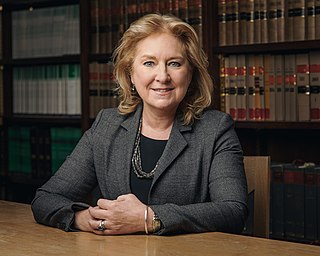
The lady chief justice of England and Wales is the head of the judiciary of England and Wales and the president of the courts of England and Wales.

Charles Abbott, 1st Baron Tenterden, was a British barrister and judge who served as Lord Chief Justice of the King's Bench between 1818 and 1832. Born in obscure circumstances to a barber and his wife in Canterbury, Abbott was educated initially at a dame school before moving to The King's School, Canterbury in 1769. He was noted as an excellent student, receiving an exhibition scholarship from the school in March 1781, when he matriculated at Corpus Christi College, Oxford. Here he was elected a fellow, and also served as a tutor to the son of Sir Francis Buller, which first made him consider becoming a barrister. He joined the Middle Temple in 1787, transferring to the Inner Temple in 1793, and was called to the Bar by the Inner Temple in 1796. Abbott was noted as an excellent barrister, earning more than any other during his time at the Bar, despite being considered unimaginative and a poor speaker. He was offered a position as a Justice of the Court of Common Pleas in 1808, which he turned down; he accepted the same offer in 1816, receiving the customary knighthood and being appointed a Serjeant-at-Law.

The Crown Court is the criminal court of first instance in England and Wales responsible for hearing all indictable offences, some either way offences and appeals of the decisions of magistrates' courts. It is one of three Senior Courts of England and Wales.
Circuit courts are court systems in several common law jurisdictions. It may refer to:
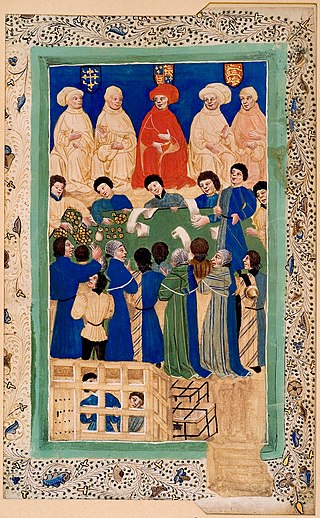
The Exchequer of Pleas, or Court of Exchequer, was a court that dealt with matters of equity, a set of legal principles based on natural law and common law in England and Wales. Originally part of the curia regis, or King's Council, the Exchequer of Pleas split from the curia in the 1190s to sit as an independent central court. The Court of Chancery's reputation for tardiness and expense resulted in much of its business transferring to the Exchequer. The Exchequer and Chancery, with similar jurisdictions, drew closer together over the years until an argument was made during the 19th century that having two seemingly identical courts was unnecessary. As a result, the Exchequer lost its equity jurisdiction. With the Judicature Acts, the Exchequer was formally dissolved as a judicial body by an Order in Council on 16 December 1880.

A Serjeant-at-Law (SL), commonly known simply as a Serjeant, was a member of an order of barristers at the English and Irish Bar. The position of Serjeant-at-Law, or Sergeant-Counter, was centuries old; there are writs dating to 1300 which identify them as descended from figures in France before the Norman Conquest, thus the Serjeants are said to be the oldest formally created order in England. The order rose during the 16th century as a small, elite group of lawyers who took much of the work in the central common law courts.
A recorder is a judicial officer in England and Wales and some other common law jurisdictions.
Nisi prius is a historical term in English law. In the 19th century, it came to be used to denote generally all legal actions tried before judges of the King's Bench Division and in the early twentieth century for actions tried at assize by a judge given a commission. Used in that way, the term has had no currency since the abolition of assizes in 1971.
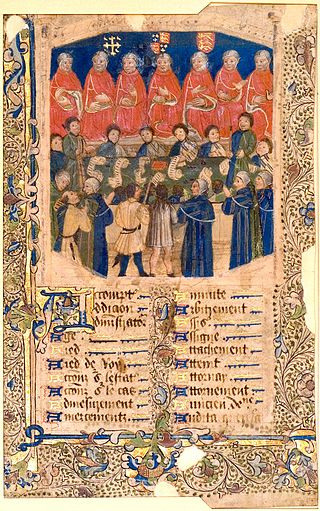
The Court of Common Pleas, or Common Bench, was a common law court in the English legal system that covered "common pleas"; actions between subject and subject, which did not concern the king. Created in the late 12th to early 13th century after splitting from the Exchequer of Pleas, the Common Pleas served as one of the central English courts for around 600 years. Authorised by Magna Carta to sit in a fixed location, the Common Pleas sat in Westminster Hall for its entire existence, joined by the Exchequer of Pleas and Court of King's Bench.

Sir Alexander James Edmund Cockburn, 12th Baronet was a British jurist and politician who served as the Lord Chief Justice for 21 years. He heard some of the leading causes célèbres of the nineteenth century.
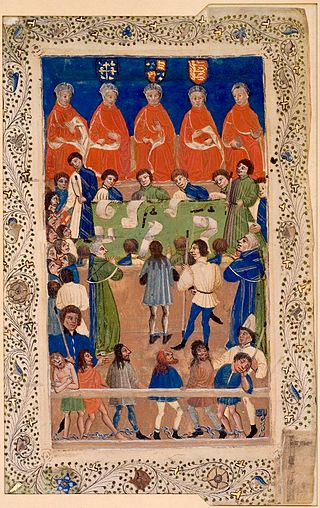
The Court of King's Bench, formally known as The Court of the King Before the King Himself, was a court of common law in the English legal system. Created in the late 12th to early 13th century from the curia regis, the King's Bench initially followed the monarch on his travels. The King's Bench finally joined the Court of Common Pleas and Exchequer of Pleas in Westminster Hall in 1318, making its last travels in 1421. The King's Bench was merged into the High Court of Justice by the Supreme Court of Judicature Act 1873, after which point the King's Bench was a division within the High Court. The King's Bench was staffed by one Chief Justice and usually three Puisne Justices.

The assizes, or courts of assize, were periodic courts held around England and Wales until 1972, when together with the quarter sessions they were abolished by the Courts Act 1971 and replaced by a single permanent Crown Court. The assizes exercised both civil and criminal jurisdiction, though most of their work was on the criminal side. The assizes heard the most serious cases, most notably those subject to capital punishment or, later, life imprisonment. Other serious cases were dealt with by the quarter sessions, while the more minor offences were dealt with summarily by justices of the peace in petty sessions.

The Wonderfull Discoverie of Witches in the Countie of Lancaster is the account of a series of English witch trials that took place on 18–19 August 1612, commonly known as the Lancashire witch trials. Except for one trial held in York they took place at Lancaster Assizes. Of the twenty men and women accused – amongst them the Pendle witches and the Samlesbury witches – eleven were found guilty and subsequently hanged; one was sentenced to stand in the pillory, and the rest were acquitted.
Sir James Peter Comyn was an Irish-born barrister and English High Court judge. The scion of a prominent Nationalist legal family, Comyn was sent to England after they fell out with Éamon de Valera. Considered by many to be "the finest all-round advocate at the English bar", Comyn was appointed to the High Court of Justice in 1978, serving on the bench until his retirement in 1985.
Ellis Beckingham, named Ellis of Beckingham in some sources, was a parish priest for Warmington, Northamptonshire, which at the time was under the authority of Peterborough Abbey, and with which Beckingham had a close relationship throughout his life. He both assisted the Abbey legally and increased his wealth through their grants. He was also a royal judge, and is possibly best known for being the only English judge to keep his position when most of his colleagues were dismissed. As a result, he has been called "with one exception the only honest judge" of the time. The dates of his birth and death are unknown, but he is thought to have died in around 1307.
The Black Assizes is an epithet given to several outbreaks of "gaol fever" which struck various prisons and court-houses in England in the late 16th century and which caused the deaths of not only many prisoners awaiting trial but also the magistrates in the court buildings holding assizes.
The Court of Common Pleas of the County Palatine of Lancaster, sometimes called the Common Pleas of or at Lancaster was a court of common pleas that exercised jurisdiction within the County Palatine of Lancaster until its jurisdiction was transferred to the High Court by the Supreme Court of Judicature Act 1873. It was a Superior Court of Record, exercising, within the limits of the County Palatine, a jurisdiction similar to that of the superior courts of common law at Westminster.
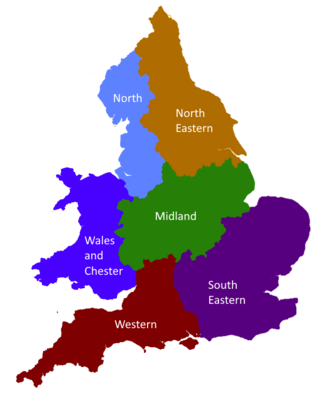
Circuits are the highest-level administrative divisions of the Bar of England and Wales and His Majesty's Courts and Tribunals Service. Today, they serve as professional associations for barristers practicing within their areas, as well as administrative divisions for the purposes of administration of justice.